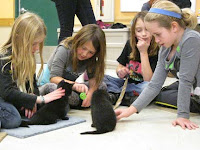One of my first experiences with an animal shelter was a little more than 16 years ago. At that time I had a sheltie and was considering getting another one. An acquaintance mentioned that she'd seen a sheltie at the local shelter. The next day I stopped in to take a look.

By that time the dog I'd originally come to see had already been adopted, but I walked up and down the rows of caging looking at the other dogs that needed homes. One of the dogs was housed in a cage on the second level of a stainless steel caging unit. With her black and white markings and cute papillon ears, she was adorable. When they took her out for me I knelt on the floor and she immediately put her front paws on my knees and leaned up to lick my face. I was sold -- the next day Belle came home with me.
When I think back to that visit it strikes me how much things have changed in animal sheltering in the southeastern part of Wisconsin.
First of all, I was allowed to take Belle home without her having met my other dog at the time beforehand. I don't know of any shelter in this part of the state that wouldn't require that the other dog(s) in the household meet the potential adoptee first. This is to ensure as best as possible that the dogs will be compatible. While it's difficult to predict this with 100% reliability based on a single meeting, now that I work at a shelter I can say that sometimes it rules out an adoption based on the extreme behavior by one or both dogs.
Another difference is how Belle was being housed. She was in a unit of cages on the second level -- something similar to how HAWS currently houses our cats. In 2009 Wisconsin passed legislation unofficially dubbed the
"Wisconsin Puppy Mill Law". Aimed at improving the poor conditions in which many puppy mills keep their dogs, it applies to most animals shelters and rescues as well since it applies to any individual, business or organization selling 25 dogs or more a year.
The
law dictates how big an enclosure should be for a dog based on the dog's size. According to the current law, today the shelter would be required to keep Belle in an enclosure of 12 square feet -- much larger than the cage she was in when I first saw her.
When I first started working at HAWS almost 9 years ago I heard stories of the way the dog kennels used to be about 5 or 6 years before that. In those days every kennel was almost always filled, and most of the time our puppy pits contained at least one litter of unwanted puppies.
Today we always have at least a few kennels, and many times only half of our dog kennels contain dogs. It's very rare that a litter of puppies actually comes in -- and when we do have a litter of puppies up for adoption many times they were taken in from shelters in other areas of Wisconsin.
Another change that I've seen occur at shelters in this area is an increased
awareness for mental and physical exercise. All shelters that I know of have a
volunteer dog walking program. As a matter of fact the new Puppy Mill Law
requires that dogs got a minimum of 30 minutes of exercise a day. HAWS easily
exceeds that with most adoptable dogs getting 2 or 3 walks, if not more, a day.
Most shelters also have some kind of program in place where
dogs are given training or are on behavior modification programs. Not only does
this make the dogs more adoptable, but it gives them an opportunity to use
their brains, boredom, and allows them more time with people.
There are many more changes in animal welfare. While I've
only talked about the changes for dogs, there are many extremely positive
things happening for cats and other animals as well. The days of animal
shelters being merely a "pound" where unwanted animals were housed with
the hope that maybe they might get adopted are over. Shelters are doing a lot
to make an animal's stay as positive as possible, and as a result give pets a
better chance of adoption.
 Last week HAWS held our annual Kids N Critters Winter Camp. 32 kids between the ages of 6 and 13 years of age attended and were able to spend time with animals, bake cookies with animal shaped cookie cutters, make pinecone bird feeders, and get a short sled time.
Last week HAWS held our annual Kids N Critters Winter Camp. 32 kids between the ages of 6 and 13 years of age attended and were able to spend time with animals, bake cookies with animal shaped cookie cutters, make pinecone bird feeders, and get a short sled time. 








